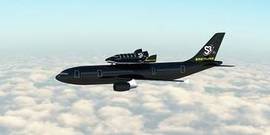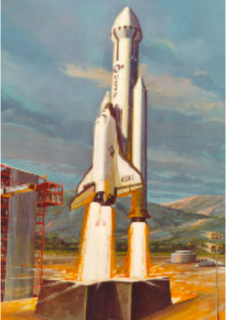 W
WA reusable launch system is a launch system that allows for the reuse of some or all of the component stages. To date, several fully reusable suborbital systems and partially reusable orbital systems have been flown.
 W
WCALLISTO is a single stage and reusable VTVL demonstrator propelled by rocket engine and developed jointly by the German Aerospace Center, the French Space Agency, and the Japanese Aerospace Exploration Agency.
 W
WA reusable launch system is a launch system that allows for the reuse of some or all of the component stages. To date, several fully reusable suborbital systems and partially reusable orbital systems have been flown.
 W
WThe Goodyear Meteor Junior was a 1954 concept for a fully reusable spacecraft and launch system designed by Darrell C. Romick and two of his colleagues employed by Goodyear Aerospace, a subsidiary of the American Goodyear Tire and Rubber Company. Darrell Romick originally estimated that the craft would cost about the same as an intercontinental B-52 bomber.
 W
WNational Security Space Launch (NSSL) — formerly Evolved Expendable Launch Vehicle (EELV) from 1994 to 2019 — is a program of the United States Space Force (USSF) intended to assure access to space for United States Department of Defense and other United States government payloads. The program is managed by the Space Force's Space and Missile Systems Center SMC, specifically the SMC's Launch Enterprise Systems Directorate, in partnership with the National Reconnaissance Office.
 W
WNew Shepard is a vertical-takeoff, vertical-landing (VTVL), crew-rated suborbital launch vehicle developed by Blue Origin as a commercial system for suborbital space tourism. Blue Origin is owned and led by Amazon founder and former CEO Jeff Bezos.
 W
WIn rocketry, the Armadillo Aerospace Quad vehicle called Pixel is a computer-controlled VTVL rocket that was used in 2006 to compete in the Lunar Lander Challenge.
 W
WSOAR was a partially reusable air-launched spaceplane launch system concept designed to launch small satellites on a suborbital or orbital trajectory. The vehicle, derived from the Hermes spacecraft developed by the European Space Agency, was planned to be built, launched, and operated by Swiss Space Systems. The spaceplane was planned to launch from an Airbus A300 aircraft named S3 Zero Gravity Airliner. Once at altitude, the spaceplane was planned to separate from the aircraft and ignite an NK-39 engine developed by the Russian Federal Space Agency. After fuel depletion at about 80 kilometers altitude, the plane was planned to release its payload before gliding back and landing on Earth.
 W
WSpaceShipOne is an experimental air-launched rocket-powered aircraft with sub-orbital spaceflight capability at speeds of up to 3,000 ft/s (900 m/s), using a hybrid rocket motor. The design features a unique "feathering" atmospheric reentry system where the rear half of the wing and the twin tail booms folds 70 degrees upward along a hinge running the length of the wing; this increases drag while retaining stability. SpaceShipOne completed the first crewed private spaceflight in 2004. That same year, it won the US$10 million Ansari X Prize and was immediately retired from active service. Its mother ship was named "White Knight". Both craft were developed and flown by Mojave Aerospace Ventures, which was a joint venture between Paul Allen and Scaled Composites, Burt Rutan's aviation company. Allen provided the funding of approximately US$25 million.
 W
WThe Scaled Composites Model 339 SpaceShipTwo (SS2) is an air-launched suborbital spaceplane type designed for space tourism. It is manufactured by The Spaceship Company, a California-based company owned by Virgin Galactic.
 W
WThe Starship system is a fully reusable, two-stage-to-orbit super heavy-lift launch vehicle under development by SpaceX and as of August 2021, it is the world's tallest and most powerful rocket ever built, with more than twice the thrust of the Saturn V. The system consists of a booster stage named Super Heavy and a second stage, also called "Starship". Unlike a traditional launch vehicle second stage, the Starship second stage is being designed to also serve as a long‑duration cargo and passenger‑carrying spacecraft, as well as a lander to transport cargo and crew to the surfaces of bodies such as the Moon and Mars. Both stages of the launch vehicle are designed to be capable of being recovered and reflown.
 W
WDuring the lifetime of Space Shuttle, Rockwell International and many other organizations studied various Space Shuttle designs. These studies included different ways to increase shuttle payload capability, crew capacity, and developing standalone reusable launch vehicles. A large focus of the program was towards new shuttle boosters and an upgrades to the external tank but also looked to expand NASA's ability to launch deep space missions and build large modular space stations. Many of these concepts and studies would shape the concepts and programs of the 2000s such as Constellation, Orbital Space Plane Program, and Artemis program.
 W
WMasten Space Systems is an aerospace manufacturer startup company in Mojave, California that is developing a line of vertical takeoff, vertical landing (VTVL) rockets, initially for uncrewed research sub-orbital spaceflights and eventually intended to support robotic orbital spaceflight launches.
 W
WMasten Space Systems is an aerospace manufacturer startup company in Mojave, California that is developing a line of vertical takeoff, vertical landing (VTVL) rockets, initially for uncrewed research sub-orbital spaceflights and eventually intended to support robotic orbital spaceflight launches.
 W
WMasten Space Systems is an aerospace manufacturer startup company in Mojave, California that is developing a line of vertical takeoff, vertical landing (VTVL) rockets, initially for uncrewed research sub-orbital spaceflights and eventually intended to support robotic orbital spaceflight launches.